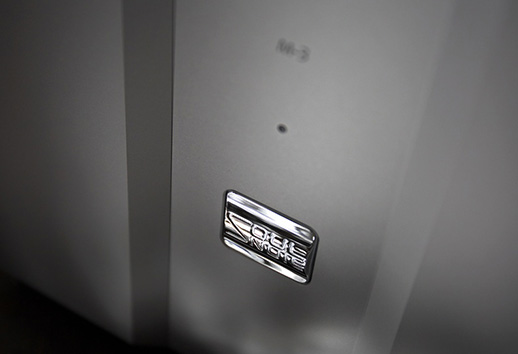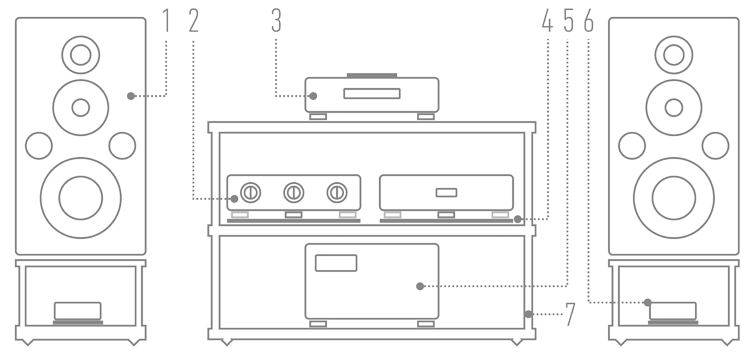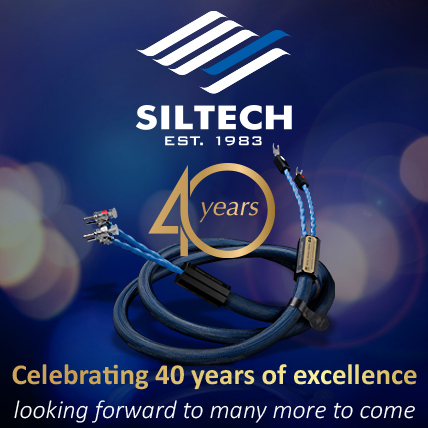|
POWER AMPLIFIER ⸜ monaural SOULNOTE
Manufacturer: CSR INTERNATIONAL Ltd. |

|
Review
text by WOJCIECH PACUŁA |

|
No 253 June 1, 2025 |
|
˻ EUROPEAN PREMIERE ˼
LAST YEAR, Japanese company Soulnote celebrated a round anniversary - twenty years in business. Its name is stylized by the manufacturer as SoulNote, which is supposed to emphasize the commitment to the spiritual experience of music. Exactly two years ago, writing a similar introduction to a test of the M-3 monoblocks, I predicted that its top-of-the-line “3” series would be completed shortly thereafter. 
As it turned out - I was right. Although not quite. The “right” part was that at the end of the year the A-3 integrated amplifier was ready (tested → HERE ˻PL˺), and in July 2024 the A-3 Core power amplifier was introduced. The presentation of the M-3X monoblock was therefore a surprise - and that would be the “not quite” part. | Timeline SOULNOTE BRAND, owned by CSR International, did not make its presence felt in Europe until the second decade of the 2000s. In “High Fidelity” we tested its first device, the 710 integrated amplifier, on May 16th 2014; more → HERE. The first product designed by Hideki Kato-san, the new chief engineer who joined the company in 2016, was the A-2 integrated amplifier (tested → HERE). The first device in the top-of-the-line “3” series was unveiled in 2019 - it was the S-3 SACD player, which we tested in its “2nd” version in 2021 (more → HERE). The P-3 preamplifier received the STATEMENT IN HIGH FIDELITY 2022 award, awarded jointly by hifistatement.net and “High Fidelity” magazines, and the A-3 integrated amplifier won our Best Sound 2023 award. The M-3 monoblocks were presented at the High End 2022 show (more → HERE).
2016 → A-1, C-1, E-1, A-0 ▌ M-3X FROM THE OUTSIDE, you can't tell any differences between the M-3 and M-3X models. Even the marking on the front panel is the same - it lacks the letter “X”. Both versions are monaural power amplifiers, which are referred to as 'monoblocks'. For stereo listening you need two such devices. Separating each channel into a separate chassis almost completely eliminates inter-channel cross-talk and improves current efficiency. Also, the basic features remain unchanged, except for one element - we’ll get back to it in a moment: push-pull output stage, operating in class AB, with a 4-stage Darlington circuit with TO-3 type terminal transistors (in a metal can), As I wrote on the occasion of the M-3 test, the body of the monoblocks has great proportions. The amplifiers are quite large - measuring 340 × 251 × 512 mm - heavy - and weighing 31 kg each, they seem really sleek. The front of the amplifier is virtually empty, not counting the chrome logo and a blue LED indicating power on. And we apply the voltage by switching a sizable switch located on the side panel. 
There's not much to look at on the back either, as there are only speaker terminals and a single XLR socket - the M-3X requires a balanced signal feed. A bit of variety is introduced by the sides of the device, where you can see a large Soulnote logo formed by cooling holes. MECHANICS • So far it looks quite ordinary, doesn't it? But when we get closer, connect in the plugs, move the top panel and take a look at the bottom of the chassis, our eyes open wider. Therefore, we start not with the electrical circuit, although it is equally important, but with something that is not as advanced in the vast majority of devices of this type - the mechanics. The M-3X is one of the most complex amplifiers I have seen in this regard. All sections of the unit are physically separated from each other. Both the electronics boards, the side panels, the bottom and top panels, the transformer and power supply - each of these components is an independent whole, which only “lies” in a given place and is not permanently screwed down to anything. Also, the aluminum boards the speaker terminals are installed to, separately the XLR input and - on its own plate - the power supply socket, are independent of each other and they “float”. To keep it from flying away, everything is mounted on pins via titanium washers. Vibrations can be extinguished, by converting them to heat, already in the amplifier, but they can also be sent outside and their energy can be exhausted there. In this company's devices, they are sent out with spikes. Separately, the chassis is supported, with three spikes - on the sides and on the back - and an aluminum rack on which the transformer and the electronics PCB are mounted - here the spikes are on the sides, and one on the front. As you can see, this is a design in which the electronics are mechanically separated from the chassis. And there is another layer of decoupling. The amplifiers are sold with an anti-vibration platform. On the surface, they appear to be simply boards glued together from wooden rafters, with a cutout in the middle. In fact, they are much more than that. As Mr. Kato says, he spent a lot of time sizing them up and sizing these holes to match the resonant frequency of the system so that the sound would be as good as possible. So he approached this problem more like a luthier than an engineer. The platforms in question are, in the case of the M-3X, much larger than the outline of the amplifier - they measure 66 x 45 cm and, via metal pins, rise above the floor to a height of 8.5 cm. The vibration dissipation and reduction system is based on spiked supports, which we usually refer to as “spikes”. The amplifiers come with templates that allow us to position the device exactly where the designer intended. ELECTRONICS • On the mechanical side, the two designs, that is, the M-3 and M-3X, are the same. Electrically, they are also remarkably similar, except for one but crucial detail: the current stage. The amplification circuit in the M-3 was based on a pair of Darlington transistors in a push-pull arrangement, housed in TO-3 type metal cases. The M-3X model has two, in parallel, instead of a single pair. Simple? - Apparently so, Accuphase, for example, uses multiple parallel systems, thus reducing the output impedance and thus increasing the output attenuation. For Mr. Kato, however, such an approach, by the way, typical in the audio world and absolutely plausible from the engineering side, was uncomfortable. This is because the problem is the spread of transistor parameters. No two units are identical. When you connect two dissimilar components in parallel, the circuit changes its characteristics with the frequency and bias. Companies get around this problem by matching transistors and compensating for the changes in question. But neither pairing ensures 100% compatibility, nor does compensation leave the sound unaffected. That's where the ideas for a high-current output stage composed of individual transistors come from. One manufacturer for whom this is equally important is Denon. It reaches for a single pair of current transistors in its amplifiers. They called their solution UHC-MOS (Ultra High Current - ed.) Single-Ended Push-Pull. Soulnote's idea is similar, but not identical. As we read a the brand's website, a new transistor pairing method was developed in-house specifically for this amplifier:
The M-3X uses NOS-type Darlington transistors, with worn-out markings. Similar models once produced by Motorola now cost more than $500 apiece. Although they look like a single transistor, they are two transistors operating in a Darlington circuit. “Darlington” (or ‘Darlington transistor’) is an arrangement of two or more - here four - giving high gain. It was developed in 1953 by Sidney Darlington at Bell Laboratories, hence its name. It has its problems, but its primary advantage - high output - is hard to overestimate. Especially since it is achieved with a very short signal path. The transistors in the tested amplifier were bolted to massive copper plates, which are part of the electrical system. Since the TO-3 chassis had outputs from below, Soulnote took advantage of this to skip the wiring and solder them directly to the amplifier board. As we read in the company materials, this eliminated the parasitic capacitance problems that arise with the inevitable deterioration of the mechanical properties of the pads under the transistors. 
When designing the M-3X, one of Mr. Kato's priorities was a short signal path. That's why the voltage (input) circuit operates without feedback and consists of one stage, and this stage consists of four transistors; the company called this R-type circuit. As the manufacturer says, four bipolar transistors and ten resistors work in it, and the circuit “is essentially the same as those used in single-ended tube amplifiers.” Add that the resistors in question are high-end, some of the best, so-called “naked” resistors, that is, without a body around the resistive elements. Let’s not forget about the power supply. Its base is a 1.6 kW toroidal transformer in a shielding housing, flooded with a damping material. The latter, however, is not the usual epoxy resin, but a different, non-descript material used by the manufacturer. The transformer is bolted vertically, parallel to the front panel, so that, as the designer says, the scattered field runs parallel to the amplifier circuit boards. As in other Soulnote devices, instead of several large capacitors there is a bank of many smaller ones, with a total capacitance of 470 μF. The manufacturer says this type of circuit is much faster, which is important for transients, than using several large ones. |
▌ SOUND ⸜ HOW WE LISTENED The Soulnote M-3X power amplifiers stood in the same place as their M-3 version two years ago, and played in exactly the same configuration. The M-3X were thus compared to my reference amplifier, the Soulution 710 solid-state power amplifier, and drove Harbeth M40.1 speakers. 
The initial amplification of the signal was handled by the Ayon Audio Spheris III tube preamplifier, but the manufacturer has its own P-3 preamplifier, one you should start your listening sessions with. The set looks very good and sounds just as well. The signal between the preamplifier and the power amplifier(s) in both cases was carried by an Acoustic Revive Triple-C XLR interconnect. The amplifiers were powered by Acoustic Revive Absolute Power cables, but I also tried Kryn Helco's regular braided cables (tested on May 16th.). The signal to the speakers in my system is carried by Siltech Triple Crown speaker cable. However, it is very stiff, so for some time in such cases I have been using a second, equally great cable - Crystal Cable Art Series Da Vinci (tested → HERE). The signal source was an Ayon Audio CD-35 HF Edition SACD player. RECORDINGS USED FOR THE TEST ⸜ a selection
⸜ AKIRA TANA TRIO, A New Picture I, ShinRec SRCD-8030, CD ⸜ 2024. AKIRA TANA TRIO'S CD entitled A New Picture I can be played in several ways. It can be a somewhat distanced presentation, with a fair amount of reflected sounds, it can be close playing with almost tangible sounds, as well as what I heard with the M-3X. That is, a presentation of almost immediate presence, in which there is no “veil” or even “mist” between us and the performers, as is sometimes said, and events materialize as they happen. But it is also a sound in which selectivity and details within the instruments are sacrificed for the sake of the overall picture. 
The reason I recall this album is that it was recorded in the studio, but “live”, directly on two tracks, without overdubs, using two microphones. They used Peluso Microphone Lab P-87, large-diaphragm microphone, a variation of the classic Telefunken U89. The preamplifier is a proprietary tube design by Mr. Shunya Sato. I bring up these details because in such a purist recording everything matters and there is no way to hide mistakes, errors or just bad luck. The sound you get with it and the M-3X, is spectacular. Much more palpable than with similar Chesky Records recordings, and much better embedded in reverb than with Naim's True Stereo recordings. With the Soulution 710 amplifier, the sound was close to me, while with the Air Tight ACT-1E tested earlier, it was placed further away. With Mr. Kato's amplifiers it was somewhere “in between.” In the sense that the tangibility was amazing and the sense of bringing the performers into our room was excellent. At the same time, it was not that the sounds were tiring. The combination of the direct, unobstructed transfer of energy that this recording provides, was not combined with the onslaught of sounds, with their pressure on us. This is simply not just a high-end recording, but a very good production that must take into account also that we will be listening to this music in a home environment. The Japanese monoblocks did an excellent job of demonstrating these intentions, and confirmed that they fully realized. Reaching for a complex studio production such as NOVIKI's Tricks Of Live album, that I have been listening to for years, I also realized that Japanese amplifiers have a tendency to play “like a tube amps”. In the sense that the way they form sound is remarkably complex internally, very attentive to tonal relations and somewhat warm. It's a performance devoid of sharp attack, but the upper treble has high energy. There's as much of it as there needs to be, and yet we read its presence more by how open the midrange is rather than by the strong cymbals. While there was plenty of that with the A New Picture I disc, it was now audible that with non-acoustic material, heavily produced, the amp in some way, known only to itself, softens the uneven edges, artifactual finishes of the sounds. It was quite warm playing, but not with the warmth of the emphasized midrange, but the smoothing of the leading edge. The lows were excellent in their mass, saturation and dynamics, but it also wasn’t them that made the Soulnote amps sound like tube amplifiers. On the one hand it would be the excellent “entering” into the sound, like with SET tubes, and on the other hand we get something that with a low power amplifier we don’t get to experience: fullness and “presence”. I mean presence of mass, not contour. It's a colossal difference, and anyone who has experienced what amplifiers like Soulution or Soulnote offer knows that it's something you miss afterwards. Even if we find something else that delights us in one or the other respect. 
What's cool about M-3X is that they organize the presentation in a way that makes it interesting. That is, they don't pressure us, but encourage us, if that's how I can anthropomorphize them. And they do it differently each time. They don't impose themselves on the recordings, although they moderate them. That is, you can hear their influence on the sound, it's not “neutral” playing, but rather “involved”. Because everything that passes through the M-3X system acquires a kind of nobility. Seemingly nothing, and yet - a different sound. Let's listen, for example, to the album Just Coolin', with unreleased material planned for a studio album by ART BLAKEY & THE JAZZ MESSENGERS. The album was recorded on March 8th 1959 at Rudy Van Gelder's (1924-2016) studio in Hackensack, New Jersey, but due to other plans by the publisher, it was shelved and lived to be released exactly sixty-one years later; in Japan it came out on SHM-SACD. After Novice, it was like letting fresh air into the room - not musically, but color-wise. It turns out that the studio recording by, using this pseudonym, Katarzyna Nowicka is very conservative at the top of the band, as if the producers were concerned with maintaining proportions also in the club, where it was supposed to sound with powerful speakers and a rather emphatic sound. In contrast, the Just Coolin' is recorded as if we were sitting in a small club, a few meters away from the performers. We've already had a few beers, so the beat of metal cymbal or snare drums is not attacking, but put through a kind of “film”. Yet this is very tangible and direct playing. Studio-like, but lively. Even the piano, an instrument set on the listening axis, usually dulled at Van Gelder's, here was perfectly clear. Yes, it had a dark tone, Lee Morgan's trumpet was the highlight, Hank Mobley's saxophone sounded stronger every now and then, but even Bobby Simmons' instrument played in the background was an important part of the playing. What the Soulnote amplifiers showed effortlessly, as if “between the words.” For it is an extraordinarily resolving device. And superbly differentiating. And at the same time “with character”. These are monoblocks that will play medieval music from Agnieszka Budzinska-Bennett's ENSEMBLE PEREGRINA Cantrix as well as PETER GABRIEL's So with equal commitment. The latter is quite sharp in attack and has pumped up bass, especially in the remastered 2003 SACD version, the discs of which, interestingly, were pressed in Japan. When I want to see if the tested device has a hardened attack, or if it hides the treble, I listen to the ˻ 2 ˺ Sledhammer with it. It's a dense, powerful, almost aggressive recording that needs to be listened to loudly. And then every deviation is at hand. But not with the M-3X. With these excellent amplifiers, one could hear the producer’s choices and emphasis on the upper midrange, on a “multitude” of sounds with a sharp attack placed in a narrow bandwidth and within short time. However, it was not unpleasant. The Soulnote did not soften anything, in which it differs, however, from warm tube amplifiers, such as the aforementioned Air Tight power amplifier. It also differs in this respect from the M-3 version, much more “rounded” in attack and warmer. 
The “X” version is both warm and open, dynamic and energetic, and also, as with ˻ 3 ˺ Don’t Give Up, romantic. The Japanese amplifier boosted Tony Levin's bass, but it was so boosted by Tony Cousins remastering. The Japanese amps simply showed its fullness and power. ▌ Summary The M-3X power amplifiers are wonderful devices with great energy, a big, deep, natural, though not going for selectivity, soundstage and a character that brings them closer to tube products. And with power that gives control even over such difficult speakers as the Harbeth M40.1. Much closer to the sound of Moon electronics than Naim, they are closer to the sound of Ayon Audio amplifiers than Accuphase. The most important thing, however, is that they perfectly combine many features that we usually look for separately. And that's why Soulnote's M-3X are simply excellent. ● ▌ Technical specifications (according to the manufacturer):
Maximum output: 240 W (2.7 Ω) 
THIS TEST HAS BEEN DESIGNED ACCORDING TO THE GUIDELINES adopted by the Association of International Audiophile Publications, an international audio press association concerned with ethical and professional standards in our industry, of which HIGH FIDELITY is a founding member. More about the association and its constituent titles → HERE. |

|
Reference system 2025 |
|
 1) Loudspeakers: HARBETH M40.1 |REVIEW| 2) Line preamplifier: AYON AUDIO Spheris III Linestage |REVIEW| 3) Super Audio CD Player: AYON AUDIO CD-35 HF Edition No. 01/50 |REVIEW| 4) Stands (loudspeakers): ACOUSTIC REVIVE (custom) |ABOUT| 5) Power amplifier: SOULUTION 710 6) Loudspeaker filter: SPEC REAL-SOUND PROCESSOR RSP-AZ9EX (prototype) |REVIEW| 7) Hi-Fi rack: Hi-Fi rack: finite elemente MASTER REFERENCE PAGODE EDITION Mk II, more → HERE |
|

|
Cables Analog interconnect SACD Player - Line preamplifier: SILTECH Triple Crown (1 m) |ABOUT|» ANALOG INTERCONNECT Line preamplifier → Power amplifier: Siltech ROYAL SINLGE CROWN RCA; review → HERE Speaker cable: SILTECH Triple Crown (2.5 m) |ABOUT| |

|
AC Power Power cable | Mains Power Distribution Block - SACD Player: SILTECH Triple CrownPower (2 m) |ARTICLE| » POWER CABLE Mains Power Distribution Block → Line preamplifier: Acoustic Revive ABSOLUTE-POWER CORD, review → HERE » POWER CABLE Mains Power Distribution Block → Power amplifier: Acoustic Revive ABSOLUTE-POWER CORD, review → HERE Power cable | Power Receptacle - Mains Power Distribution Block: ACROLINK Mexcel 7N-PC9500 (2 m) |ARTICLE| Power Receptacle: Acoustic Revive RTP-4eu ULTIMATE |REVIEW| » ANTI-VIBRATION PLATFORM under Acoustic Revive RTP-4eu ULTIMATE: Graphite Audio CLASSIC 100 ULTRA, review → HERE Power Supply Conditioner: Acoustic Revive RPC-1 |REVIEW| Power Supply Conditioner: Acoustic Revive RAS-14 Triple-C |REVIEW| Passive filter EMI/RFI: VERICTUM Block |REVIEW| |

|
Anti-vibration Speaker stands: ACOUSTIC REVIVE (custom)Hi-Fi rack: finite elemente MASTER REFERENCE PAGODE EDITION Mk II, more → HERE Anti-vibration platforms: ACOUSTIC REVIVE RAF-48H |ARTICLE| » ANTI-VIBRATIONAL FEET: |

|
Analogue Phono preamplifier: Phono cartridges:
Clamp: PATHE WINGS Titanium PW-Ti 770 | Limited Edition Record mats:
|

|
Headphones » HEADPHONE AMPLIFIER: Leben CS-600X, review → HEREHeadphones: Headphone Cables: Forza AudioWorks NOIR HYBRID HPC |
main page | archive | contact | kts
© 2009 HighFidelity, design by PikselStudio,
projektowanie stron www: Indecity














